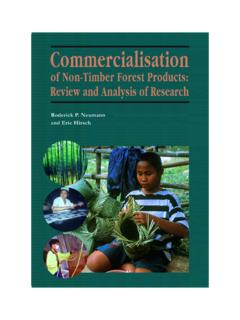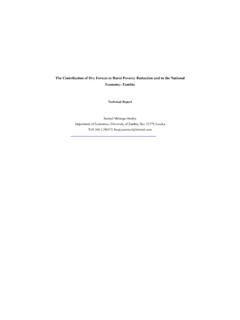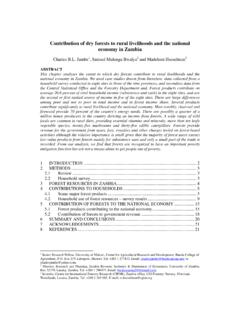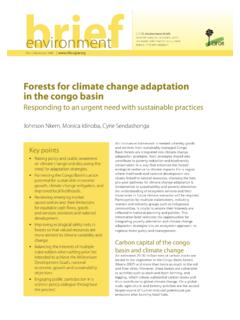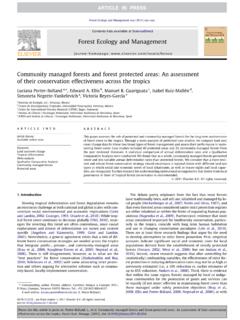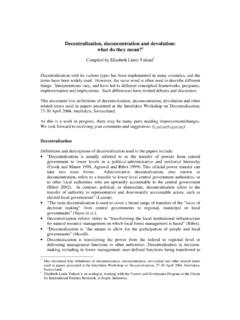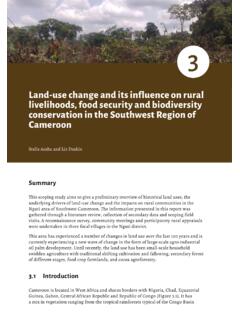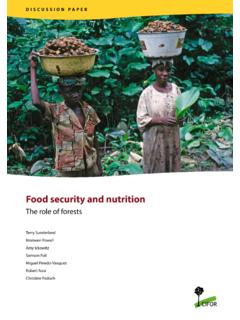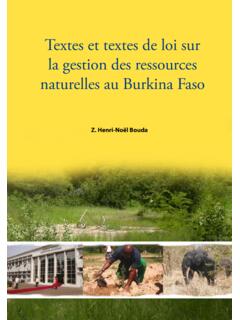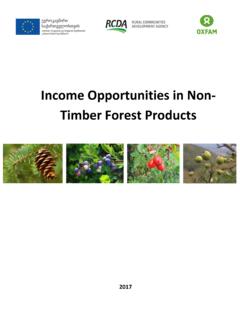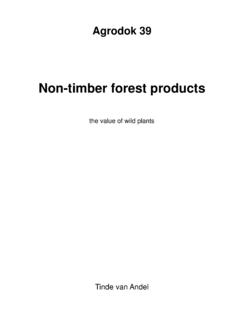Transcription of Value of non-timber forest products and rural …
1 Topic 2: non-timber forest products (NTFPs), small-scale logging and rural livelihoods Value of non-timber forest products and rural safety nets in South Africa Charlie Shackleton Sheona Shackleton Paper presented at The International Conference on rural Livelihoods, Forests and Biodiversity 19-23 May 2003, Bonn, Germany Value of non-timber forest products and rural safety nets in South Africa Charlie Shackleton1 Sheona Shackleton1 SUMMARY In common with the rest of the developing world, rural communities in South Africa make extensive use of non-timber forests products (NTFPs) for daily subsistence and income generation.
2 Use of NTFPs increases in times of household misfortunate or adversity, corresponding to a safety net role of in reducing rural vulnerability. This paper presents a summary of recent empirical data from several studies examining the prevalence, role and Value of NTFP use by rural communities in South Africa, followed by detailed examination of three case studies of NTFP commercialisation (marula beer, woodcarvings and palm hand brushes). All rural households make use of NTFPs to a greater or lesser extent. The most commonly used ones are wild spinaches, wild fruits, fuelwood, hand brushes, wooden utensils, medicinal plants, bushmeat and weaving fibres.
3 The mean gross annual direct-use Value ranges from R1000 to over R7000 per household across 14 different villages. Net values are approximately two-thirds of this. We differentiate between a daily net and an emergency net The first is the safety net function resulting from use of NTFPs on a regular basis, since they represent a saving of scarce cash resources, which may then be deployed towards other household needs. The magnitude of the cost saving is greater to poorer households than for wealthier ones. Moreover, the cost saving applies not only at the household level, but also the national level since it alleviates some of the costs that the government would incur had it to provide these services in rural areas.
4 In contrast, the emergency net is the new use, or increased use, or trade in NTFPs, in response to unexpected economic, social or climatic hardship or misfortunate. It starts out as a coping strategy and is initially on a temporary basis. However, the emergency net may evolve into a permanent livelihood strategy. Direct use values do not adequately reflect the Value of the emergency net to rural households. Commercialisation is becoming a common way in which the safety net function and Value of NTFPs to rural households is manifest, and it appears to be growing. Greater proportions of poor households engage in commercialisation than do wealthy households, and it represents a greater fraction of their total livelihood.
5 The three case studies indicate some commonalities in terms of profiles of the people participating in the trade, but also differences in relation to the nature of the resource and markets. Typically, they have low skills, education and limited employment opportunities. They have limited abilities to negotiate with buyers and officials and are price-takers. Cash returns are in proportion to effort expended, although highly variable from month to month. Some see trade in NTFPs as only a temporary activity whilst they seek or hope for permanent formal employment. Others trade in NTFPs as their primary livelihood activity, in which they take pride in being self-employed.
6 Whilst the daily net, emergency net nor NTFP commercialisation will ever alleviate household or rural poverty, they certainly ease it significantly, without which rural hardship would be more severe. Overall, the use of NTFPs adds a crucial dimension to a diversified livelihood base of most rural households, that is necessary for daily subsistence, reducing vulnerability and easing rural poverty. 1 Department of Environmental Science, Rhodes University, Grahamstown 6140, South Africa, 1 INTRODUCTION Millions of people throughout the world make extensive use of biological products from the wild (Wollenberg & Ingles 1998, Cunningham 2001, Koziell & Saunders 2001).
7 These products , commonly termed non-timber forest products (NTFPs), are harvested for both subsistence and commercial use, either on a frequent basis, or as a fall back during times of need. Both these modalities constitute a safety net function to rural dwellers. NTFPs may also have marked cultural significance and Value (Posey 1999, Cocks & Wiersum 2003). Whatever the mode and frequency of use, the contribution of NTFPs is significant within a livelihoods context. Despite the growing international appreciation of the role of NTFPs in rural subsistence and development, many uncertainties remain. Perhaps even more so for the drier and densely settled savannas of South and southern Africa (Shackleton 2001, Campbell & Luckert 2002), since much literature on the Value of NTFPs and their use and role in livelihoods comes from the tropics of Asia and South America (Neumann & Hirsch 2000).
8 Particular uncertainties in the South African context relate to (i) the prevalence of use of NTFPs for daily subsistence, (ii) the role of NTFPs as a safety net in times of need, (iii) the prevalence of NTFP commercialisation as a safety net, and (iv) the significance of NTFPs in easing rural poverty. This paper offers some answers and insights into these uncertainties in rural South Africa by examining the extent of use and Value of NTFPs at a broad scale, followed by three detailed case studies to illustrate parallels and differences in NTFP commercialisation and safety net role. APPROACH NTFP use and Value in direct household provisioning in South Africa Our approach was to summarise and interpret recent (< 5 years) data and findings from both published and unpublished sources.
9 We focussed on those studies that attempted to include a full inventory of NTFPs used by households, rather than simply one or two. Also there is an emphasis on the savanna biome, which is the largest biome in South and southern Africa. In particular, we draw heavily upon the study of three villages by Shackleton et al. (1999, 2002), and four subsequent studies, spanning 10 villages in three provinces (Magasela et al. 2001, Twine et al. 2001, Dovie et , Shackleton et al. 2002), that used the same interview schedule as Shackleton et al. (1999), and already summarised by Shackleton & Shackleton (in press).
10 In all instances, 30 or more households were sampled per village, complimented by key informant interviews and group Participatory rural Appraisal (PRA) exercises. Other studies have also been incorporated wherever possible. During the periods of fieldwork for most of these studies (1998 2001) the exchange rate varied between six and nine Rand to the US dollar. 2 Commercialisation as a safety net The same sources as above were consulted to examine the patterns and extent of commercialisation. Additionally, results from three in-depth case studies are presented, one on wood carvers, one on sellers of marula beer, and one of vendors of palm brushes.
